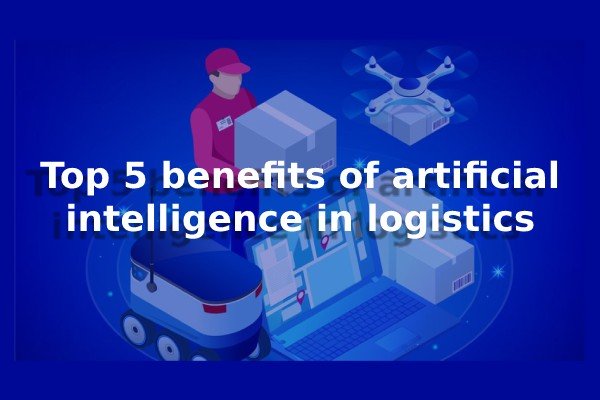Top 5 Benefits of Integrating AI in Logistics

AI entails the creation of intelligent machines that are capable of carrying out tasks that traditionally call for human intellect. Supply Chain AI is revolutionizing operations by using algorithms, data analysis, and machine learning to automate repetitive tasks, enhance decision-making, and optimize processes. It can help supply chain management businesses increase efficiency, reduce costs, and improve customer experiences.. Supply chain management can also be streamlined.
As AI can increase production, boost efficiency, and improve decision-making, its significance in optimizing operations management is expanding quickly. Businesses may use AI to analyze massive amounts of data, optimize routes, predict demand, automate procedures, and gain real-time insight, giving them a competitive edge in the dynamic transportation industry and streamlining operations.
Contents
1. Enhanced Efficiency and Productivity
Automated repetitive tasks and improved operational efficiency
By utilizing tools like robotic process automation (RPA) and machine learning, AI can automate monotonous supply chain management activities. Data entry, order processing, invoice validation, and inventory management are just a few of the activities that these technologies are capable of handling quickly and accurately. By automating these processes, AI lowers the chance of human error, improves operational effectiveness, and frees up valuable human resources to concentrate on more strategic and complicated duties. As a result, productivity increases, operating expenses are decreased, and administration processes are expedited and more dependable.
Optimized route planning, reduced idle time, and maximized resource utilization
AI is essential for streamlining route planning, cutting down on idle time, and making the most use of resources in supply chain management. AI can identify the most cost-effective transportation routes by using sophisticated algorithms and real-time data analysis, taking into account variables like traffic, weather, and delivery restrictions. This shortens travel times, uses less fuel, and increases effectiveness all around. AI may also analyze demand trends and modify scheduling and routing accordingly, reducing idle time and maximizing the use of cars and other resources, resulting in cost savings and enhanced operational efficiency.
2. Improved Forecasting and Demand Planning
AI algorithms analyze historical data to predict demand accurately
In order to estimate demand for Supply chain management services accurately, AI algorithms use historical data analysis. AI algorithms can find patterns and correlations to estimate future demand by examining historical sales data, market trends, seasonal patterns, and numerous external factors. These algorithms have the capacity to take into consideration complicated variables and produce highly precise forecasts. Shipping companies can reduce stockouts and cut costs associated with excess inventory by planning production and procurement, optimizing inventory levels, and ensuring product availability to satisfy customer expectations.
AI-driven demand planning in reducing stockouts and excess inventory
AI-driven demand planning helps operations management in a number of ways, most notably by lowering stockouts and surplus inventory. AI algorithms give businesses the ability to optimize inventory levels by properly forecasting demand, ensuring that the appropriate products are available at the right time and in the right quantities. This lowers the possibility of stockouts, boosts customer happiness, and avoids missed sales. AI also assists businesses in avoiding overstocking by offering insights on demand swings and patterns, enabling them to match inventory levels with actual customer needs and reduce the expenses associated with extra inventory.
3. Enhanced Supply Chain Visibility
Real-time tracking and monitoring of shipments
AI-powered systems make use of sensors, GPS, and sophisticated data analytics to enable real-time tracking and monitoring of shipments. The position, state, and movement of shipments are tracked and analyzed by these technologies, giving operations management operators real-time visibility. This makes it possible for them to track shipments, spot potential hiccups or delays, improve routing, and actively handle exceptions. The seamless flow of commodities across the supply chain is ensured by real-time tracking and monitoring, which also increases operational effectiveness, customer service, and decision-making.
Improved visibility on reducing delays, enhancing customer satisfaction, and managing risks effectively
Reduced delays, increased customer happiness, and effective risk management are all significantly impacted by improved visibility in Supply chain management, which is made possible by AI-powered technology. Operation managers can proactively handle possible problems, reduce delays, and guarantee on-time deliveries thanks to real-time visibility. Customer loyalty and satisfaction increase as a result. By locating bottlenecks, spotting potential interruptions, and allowing for prompt mitigation techniques, improved visibility also makes it possible for better risk management, resulting in smoother and more dependable logistical operations.
4. Predictive Maintenance and Asset Management
Analyze equipment data to detect maintenance needs proactively
Utilizing strategies like predictive maintenance, AI systems examine equipment data to identify maintenance needs early on. Sensors gather information on several characteristics including temperature, vibration, and energy usage by continuously monitoring the operation of the equipment. These data are analyzed by AI algorithms to spot trends, outliers, and potential equipment failure or degradation early on. This makes it possible for maintenance teams to plan maintenance tasks ahead of time, minimizing downtime, cutting maintenance costs, and increasing equipment uptime. The lifespan of equipment is increased and overall operating efficiency is enhanced through proactive maintenance made possible by AI algorithms.
Predictive maintenance to reduce downtime, optimize maintenance schedules, and extend asset lifespan
The use of predictive maintenance in supply chain operations has many advantages, made possible by AI algorithms. It minimizes supply chain interruptions, ensures that essential equipment remain operating, and avoids unexpected downtime by anticipating maintenance needs. In order to maximize operational efficiency, predictive maintenance also optimizes maintenance schedules, enabling businesses to schedule maintenance tasks for times when there is minimal demand or scheduled downtime. Additionally, by addressing maintenance issues in a proactive manner, assets live longer, requiring fewer replacements sooner, which reduces costs for transportation companies.
5: Data-Driven Decision Making
Data-driven insights via Machine Learning
AI analytics and machine learning enable data-driven insights in transportation by analyzing vast amounts of data obtained from many sources, such as customer orders, supply chain activities, and market trends. These tools can spot patterns, correlations, and abnormalities in data, giving decision-makers useful information. By employing AI analytics to make data-driven decisions about demand projections, route optimization, inventory management, and overall operational strategy, transport businesses may increase efficiency and gain a competitive edge.
Data-driven decision making in optimizing operations, cost reduction, and strategic planning
Strategic planning, operational optimization, and cost cutting are just a few advantages of data-driven decision making in supply chain management. Businesses can uncover inefficiencies, bottlenecks, and improvement areas in their operations by analyzing data, which results in simpler procedures and increased production. By enhancing resource allocation, lowering transportation costs, and optimizing inventory levels, data-driven insights also help to reduce expenses. In strategic planning, data-driven decision making offers useful insights into market trends, customer preferences, and the competitive landscape, enabling businesses to make educated decisions and modify their strategies to remain competitive in the fast-paced supply chain management sector.
In conclusion, the use of Artificial Intelligence in supply chain management has a wide range of advantages. These include enhanced efficiency and productivity, improved forecasting and demand planning, enhanced supply chain visibility, predictive maintenance and asset management, and data-driven decision making. With AI, operations management can achieve higher levels of optimization, cost reduction, risk management, and strategic planning, paving the way for more efficient, agile, and competitive supply chain management processes. The benefits of artificial intelligence (AI) in logistics are instrumental in transforming the industry and driving it towards greater success.









